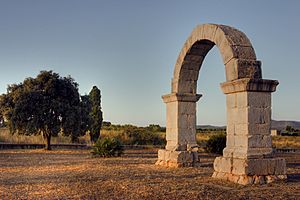Arch of Cabanes facts for kids
Quick facts for kids Roman arch of Cabanes |
|
|---|---|
| Arco Romano de Cabanes | |
| Castellón Near Cabanes in Spain |
|
 |
|
| Type | Ancient Roman triumphal arch |
| Site information | |
| Open to the public |
Yes |
| Site history | |
| Built | II century |
The Arch of Cabanes is an ancient Roman arch built around the 2nd century AD. This means it's about 1,800 to 1,900 years old! It stands about 2 kilometers (1.2 miles) from the town of Cabanes in Castellón, Valencia, Spain. You can find it on the old via Augusta, a famous Roman road, in a flat area called Pla de l'Arc.
A Look Back: The Arch's History
Historians believe the arch was built in the 2nd century AD. They found old pottery and coins from that time near its base.
This arch was likely part of a private burial site, maybe connected to a large country home (a "rural villa") in the area.
People have known about the arch for a long time. It was mentioned in old papers from 1243. Later, in 1873, a local group in charge of monuments changed the road that went under the arch. They did this to protect the arch from damage. In 1931, the arch was officially named a "historic artistic monument" and a "national artistic treasure" of Spain. This means it's a very important part of the country's history and art. In 2004, the town of Cabanes created a special plan to protect both the Roman road and the arch.
What the Arch Looks Like
Today, the Arch of Cabanes is partly in ruins. The top part of the archway is missing. What you can still see are the two main supports, called "pylons," and the arch itself. The decorative parts, like the flat bands (fascia) and the curved spaces (spandrels) above the arch, are gone.
The arch is about 5.8 meters (19 feet) tall and 6.92 meters (22.7 feet) wide.
It was built using limestone blocks. The base is made of granite blocks. The Romans built it without using mortar, which is like glue for bricks. The two square-shaped columns (pylons) are still standing. They have decorative edges at the top and bottom. The arch on top is a semicircle made of fourteen wedge-shaped stones, carefully placed to form the curve.
Images for kids
See also
 In Spanish: Arco romano de Cabanes para niños
In Spanish: Arco romano de Cabanes para niños
- List of Roman triumphal arches


